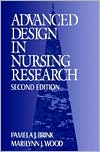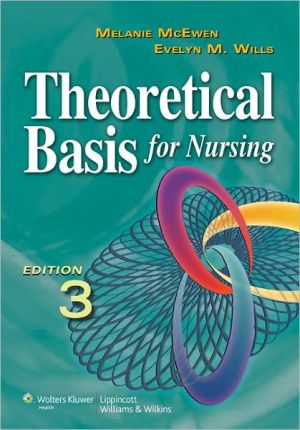Advanced Design in Nursing Research
This Second Edition of the bestselling Advanced Design in Nursing Research has been substantially revised and reorganized.\ Using the principle that the level of knowledge available on a research topic determines the level of design that can be used to study the topic, the contributors present discussions of research at three levels of design: theoretically based experimental designs; comparative and correlated survey designs; and exploratory-descriptive research designs.\ Strengths and...
Search in google:
This Second Edition of the bestselling Advanced Design in Nursing Research has been substantially revised and reorganized. Using the principle that the level of knowledge available on a research topic determines the level of design that can be used to study the topic, the contributors present discussions of research at three levels of design: theoretically based experimental designs; comparative and correlated survey designs; and exploratory-descriptive research designs. Strengths and weaknesses of each design in sampling, methods, reliability, validity, data analysis and issues related to human subjects are addressed. Contributors also discuss writing and evaluating proposals. Doris D. Coward This edited book on nursing research designs is organized in headings by level of design -- exploratory-descriptive (5 chapters), survey (5 chapters), and experimental (4 chapters). In this second edition, one chapter is revised, four are placed under different headings, and two new chapters are added. The previous edition was published in 1989. This advanced research design text is intended to provide more detail concerning nursing research designs than is found in the authors' more elementary text, Steps in Planning Nursing Research. The descriptions of the several specific research designs and methodologies, such as structural equation modeling, are well beyond the scope of the basic text. The added dimension of detail about strengths and weakness of specific designs and implementation issues clearly is useful to the advanced students and teachers of nursing research to whom the book is targeted by the authors. Advanced undergraduate students and instructors in undergraduate research courses also may be interested in such issues related to specific research designs. This is an important addition to nursing research training of graduate students and a reference for teachers of research. The two new chapters (within subject designs and the analysis technique of structural equation modeling) increase the usefulness of this edition. Although the chapter formatting is changed in this new edition, several chapters appear to be almost identical to the 1989 edition. Consequently, most of the research examples and the references in those chapters are more than 10 years old. Although designs using qualitative methods and data are presented in two chapters, in thisnew edition these designs continue to be viewed from a positivistic perspective. Researchers with a more contextual world view would prefer that qualitative approaches be discussed with a stronger emphasis on their unique contributions to scientific knowledge rather than an emphasis on their use at a beginning of a research program that will lead to more ""rigorous"" research designs.
Preface to the First EditionPreface to the Second Edition1Introduction32Classical Experimental Designs213Quasi-Experimental Designs634Within-Subject Designs1055Evaluative Designs1246Comparative Designs1437Correlational Designs1608Structural Equation Modeling1789Epidemiologic Designs21010Methodological Studies: Instrument Development23511Descriptive Designs28712Exploratory Designs30813Qualitative Research33514Historical Research35615The Pilot Study: One Key to Research Success375Author Index387Subject Index395About the Authors409
\ From The CriticsReviewer: Doris D. Coward, RN, PhD(University of Texas at Austin School of Nursing)\ Description: This edited book on nursing research designs is organized in headings by level of design — exploratory-descriptive (5 chapters), survey (5 chapters), and experimental (4 chapters). In this second edition, one chapter is revised, four are placed under different headings, and two new chapters are added. The previous edition was published in 1989.\ Purpose: This advanced research design text is intended to provide more detail concerning nursing research designs than is found in the authors' more elementary text, Steps in Planning Nursing Research. The descriptions of the several specific research designs and methodologies, such as structural equation modeling, are well beyond the scope of the basic text.\ Audience: The added dimension of detail about strengths and weakness of specific designs and implementation issues clearly is useful to the advanced students and teachers of nursing research to whom the book is targeted by the authors. Advanced undergraduate students and instructors in undergraduate research courses also may be interested in such issues related to specific research designs.\ Features: This is an important addition to nursing research training of graduate students and a reference for teachers of research. The two new chapters (within subject designs and the analysis technique of structural equation modeling) increase the usefulness of this edition.\ Assessment: Although the chapter formatting is changed in this new edition, several chapters appear to be almost identical to the 1989 edition. Consequently, most of the research examples and the references in those chapters are more than 10 years old. Although designs using qualitative methods and data are presented in two chapters, in this new edition these designs continue to be viewed from a positivistic perspective. Researchers with a more contextual world view would prefer that qualitative approaches be discussed with a stronger emphasis on their unique contributions to scientific knowledge rather than an emphasis on their use at a beginning of a research program that will lead to more "rigorous" research designs.\ \ \ \ \ Doris D. CowardThis edited book on nursing research designs is organized in headings by level of design -- exploratory-descriptive (5 chapters), survey (5 chapters), and experimental (4 chapters). In this second edition, one chapter is revised, four are placed under different headings, and two new chapters are added. The previous edition was published in 1989. This advanced research design text is intended to provide more detail concerning nursing research designs than is found in the authors' more elementary text, Steps in Planning Nursing Research. The descriptions of the several specific research designs and methodologies, such as structural equation modeling, are well beyond the scope of the basic text. The added dimension of detail about strengths and weakness of specific designs and implementation issues clearly is useful to the advanced students and teachers of nursing research to whom the book is targeted by the authors. Advanced undergraduate students and instructors in undergraduate research courses also may be interested in such issues related to specific research designs. This is an important addition to nursing research training of graduate students and a reference for teachers of research. The two new chapters (within subject designs and the analysis technique of structural equation modeling) increase the usefulness of this edition. Although the chapter formatting is changed in this new edition, several chapters appear to be almost identical to the 1989 edition. Consequently, most of the research examples and the references in those chapters are more than 10 years old. Although designs using qualitative methods and data are presented in two chapters, in thisnew edition these designs continue to be viewed from a positivistic perspective. Researchers with a more contextual world view would prefer that qualitative approaches be discussed with a stronger emphasis on their unique contributions to scientific knowledge rather than an emphasis on their use at a beginning of a research program that will lead to more ""rigorous"" research designs.\ \ \ BooknewsThe authors present discussions of research at the three levels of design, moving from rigidly controlled, theoretically based experimental designs to comparative and correlational survey designs, and concluding with the exploratory-descriptive research designs that frequently initiate the study of a topic. Within the basic categories, researchers explore a broad range of specific design types, noting their characteristics, strengths and weaknesses, applicability to nursing research, ethical considerations, reliability and validity, and methods of data analysis. Annotation c. by Book News, Inc., Portland, Or.\ \ \ \ \ 4 Stars! from Doody\ \








